|
|
 |
Canadian Historic Sites: Occasional Papers in Archaeology and History No. 19
Yukon Transportation: A History
by Gordon Bennett
Between the Wars
I
"A gold rush is like a war," George Black once explained. "You feel
it in your blood. It is exciting — intoxicating. It reveals, as in
a flash, the monotony of ordered days and ordered ways."1 By
1914 the prospect of another Yukon gold rush was little more than an
empty dream. Most of the Klondike had come under the umbrella of
consolidation and what remained would have been hard put to bestir the
enthusiasm of the most optimistic prospector. The "intoxicating" days of
1897-1900 were gone forever, replaced by the daily routine of working
for one of the large mining companies.
If another gold rush was merely the product of an imaginative mind
nourished by the interminable Yukon winter, war was not. When
hostilities broke out in Europe in August of 1914 a certain exhilaration
swept the Yukon. Black's description of the stampede spirit worked both
ways and war, though certainly less preferable than a gold rush,
nevertheless furnished excitement and relief from the "monotony of
ordered days and ordered ways" that had become the measure of life in
the territory.
But the excitement was purchased at tremendous cost. While the rest
of the nation shared, albeit with some disparity, the benefits accruing
from wartime mobilization,2 these benefits, with the notable
exception of the Whitehorse copper industry, completely by-passed the
Yukon. The impact of the war on gold mining — the backbone of the
territorial economy — was particularly severe. From 1908 through
1914 the industry had exhibited positive signs of recovery after seven
years of decreasing annual production.3 Under the influence
of wartime conditions, however, the industry found itself caught in a
vice of rising production costs and rigid gold prices. Writing in 1918,
the territorial gold commissioner observed that "each successive year
since 1914 has seen a tremendous increase in the price of all kinds of
provisions and particularly in dredge machinery and repair parts, and
there has been no increase in the value of gold mined."4 The
price-cost squeeze was further exacerbated by the withdrawal for war
service of a large number of skilled miners and supervisory personnel, a
factor that adversely affected the operational efficiency of the
industry.5 Given the region's remoteness and the inflationary
pressures unloosed by the war, it was impossible to replenish such a
drain on the labour pool from outside sources.
Within the territory itself, the war produced spectacular increases
in the cost of living. Operating on the barest of margins, the gold
companies were forced to deny labour a corresponding measure of wage
relief. In 1917 the Yukon Gold Company, the only mining concern in the
Klondike extracting enough gold to qualify as a genuine producer,
rejected the moderate demands of its employees for a "10 per cent
increase [in] wages to meet [the] 60 and 100 per cent rise on
foodstuffs." The company's intransigence was followed by an act of last
resort in an industry wholly dependent on seasonal operation: a
strike.6
No less serious than the war and of greater long-term consequence
were the managerial decisions taken within the gold mining industry
itself. During the period 1908-35 extractive operations were undertaken
on less than half the known gold-bearing fields in the Klondike. This
failure to exploit to the full the resources of the district cannot be
attributed to a deliberate policy of building up reserves and following
a programme of systematic extraction, a policy that would have been
economically sound. Rather it must be explained in terms of a single
individual's attempt to gain hegemony over the entire gold fields, an
attempt that was characterized by an almost total disregard for the
welfare of the Yukon.
It is ironical that this individual, A.N.C. Treadgold, was the
architect of consolidation. For it was Treadgold, with his intimate
knowledge of frozen gravels and the most efficient means for working
them, who had been largely responsible for the conversion to
capital-intensive mining. But Treadgold was obsessed by an even greater
dream than overseeing the revolution in mining technique which he had
initiated; he dreamed of bringing the entire Klondike under his personal
control.
Treadgold pursued his goal through the simple expedient of using the
assets of the companies with which he was associated to purchase
additional claims. Had he financed these purchases out of the profits
realized from his mining operations, he might well have achieved his aim
and maintained at the same time a satisfactory level of production, but
Treadgold employed investment capital which should have been used to
underwrite extraction. Francis Cunynghame, Treadgold's biographer, has
written that under Treadgold's stewardship, the Granville Mining Company
was "a mining company which could not produce gold and had no means to do
so."7 The same can be said of all the companies with which
Treadgold was later connected. Percy Reid, territorial gold commissioner
during the mid-1920s, expressed his exasperation with Treadgold by
dismissing him as little more than a speculator: "Mr. Treadgold is not
an operator, but is merely a promoter."8 As unfair to
Treadgold as Reid's assessment was, the gold commissioner accurately
captured Treadgold's fatal weakness that was to deprive the mining
industry of the liquid capital required to maintain its productive
capacity. The outcome of Treadgold's dream to control the Klondike was
to leave gold mining proper in a relative state of suspended animation
between 1918 and 1932 and bring about his ultimate
downfall.9
The impact of the war and Treadgold's struggle can be seen in the
annual figures for gold production published by the Dominion Bureau of
Statistics. Between 1915 and 1930 there was a protracted falling off in
production from a high of $5,125,324 in 1914 to $734,202 in 1930.
Between 1924 and 1932 total annual production did not exceed one million
dollars, hitting a low of $529,220 in 1926. In 1923 silver-lead
production in the Mayo district superseded the Klondike as the principal
mineral-producing region in the Yukon.10
On a more tangible plane, the decline in gold production found a
mirror image in the community of Dawson. Where once the mud flat at the
confluence of the Klondike and Yukon rivers had played host to an
estimated thirty thousand people, 975 were all that could be mustered
for the 1921 census.11 While falling production and a
decreasing population were not novel phenomena, Dawsonites reacted to
them in a manner that was far different after 1918 than had been the
case prior to the war. Before the war there had been a pronounced
tendency to regard post-gold-rush Dawson as a settled, progressive
community that had evolved out of the raw mining camp synonymous with
the stampede. But the war, the economic havoc created by Treadgold's
ambition to control the Klondike, and the sinking of the SS Princess
Sophia in October of 1918 destroyed this complacent
perspective.12 When Laura Berton returned to Dawson in 1920,
Dawson was not the confident little enclave she had left four years
before, but a "decaying town" sapped of its energy and spirit. The
unmistakable signs of a ghost town in the making were manifest.
Physically, the settlement possessed enough buildings to accommodate ten
times its population. The population itself, already ravaged by war, a
waning economy and the Sophia disaster, was getting progressively
older. A generation separated the Dawson of 1897-1900 from the Dawson of
1920. In the interim, immigration had been negligible. Dawson's single
hospital was full "not of patients," Mrs. Berton wrote, "but of old
men." Funerals became social events. Where a quarter of a century
before, Dawson had revolved around the gambling tables and the dance
halls, "it was the funerals around which the town revolved" during the
twenties.13
By 1920 the Dawson Daily News, the only local newspaper to
survive the century's first decade, had ceased daily publication. Four
years before, the News had carried an obituary to an era of
social history with a banner headline that proclaimed "Last Day of the
Saloon in Yukon." In 1918 the Side Streams Navigation Company of Dawson
terminated its operations, while in the same year the United States
government withdrew its consular representative from the city. At the
end of the war the total annual tonnage arriving at Dawson had declined
to less than ten thousand tons and in the words of G.B. Edwards, general
agent for the British Yukon Navigation Company, "waterfront privileges
are fast depreciating." By 1920 the only living reminder of Dawson's
golden age as an entertainment centre was a single theatre, but one
would have been hard pressed to find any resemblance between the
productions and the performers of 1899 and 1920.14
If one word best described the Dawson of 1920, that word was
"shrinkage." One could see it everywhere — in the population
figures, in the economy and in the spirit of those who remained. Even
the city itself was shrinking. Community services were too expensive to
provide over a widely scattered area and as a consequence there was a
steady concentration of people toward the core. But Dawson had a history
of escaping the ghost town fate so often predicted for it after 1900. In
this there was an unfailing and perhaps to some a perplexing
consistency. The twenties were difficult years for Dawson, but the town
survived them and when the Yukon Consolidated Gold Corporation commenced
full-scale production after 1933, Dawson was ready once more to preside
as the Yukon's major city.15
The Klondike's postwar economic slide was in large measure offset by
developments that occurred in the Mayo district during the late teens
and early twenties. The discovery of a rich silver-lead outcropping by
Louis Bouvette on Keno Hill in 191916 climaxed a 13-year search for an
extensive lode deposit in the area17 and attracted two large
companies, Keno Hill, a subsidiary of the Yukon Gold Company, and the
Treadwell Yukon Company of San Francisco, with sufficient capital to
organize the industry on an efficient basis. With the withdrawal of Keno
Hill in 1924, the way was cleared for Treadwell Yukon to establish
virtual control over the entire district. This it did with the result
that by 1926 the Mayo district and silver-lead surpassed the Klondike
district and gold as the primary producer and product in the
Yukon.18
This radical change in the territory's economic centre of gravity had
a profound impact on the transportation system. At the very time that it
was becoming increasingly apparent that the territorial economy could no
longer sustain the existing transportation system, a new challenge
issued from the Mayo district.19 This challenge was
substantially different from the challenge that had been posed in the
Klondike. It demanded a response to the transportation problem that was
in keeping with the peculiar needs of lode mining as distinct from
placer mining. In the past the transportation system had proved
singularly incapable of coming to grips with a problem of this
nature,20 but the mineral deposits of the Mayo district
enjoyed two palpable advantages over those of other areas where lode
mining had previously been attempted; a rich assay and extensive
occurrence. As a consequence, transportation was able to fulfill its
proper function; to assist a viable mining industry in moving the
products of the mine to outside buyers and to deliver the manpower and
material needs of the industry to the site of its operations. This
constituted a major shift in the burden previously borne by
transportation vis-à-vis the lode-mining industry. In the case of
Whitehorse copper, for example, transportation had been charged with the
impossible task of sustaining an industry that was initially tenuous
owing to the low-grade nature of its product.
II
That aspect of transportation most sensitive to the economic changes
of the 1920s was the road system. As we have seen, overland
transportation of the non-rail variety had assumed an ever-increasing
importance in the years immediately preceding the war, both as a
necessary adjunct to the seasonal service furnished by water and as a
vital tool in the movement of supplies and services between settlements
which were not situated on existing river routes. This was particularly
true of the Mayo district where mining properties tended to be scattered
over an area that was 40 miles from the nearest steamboat landing, the
town of Mayo, and the most accessible waterway, the Stewart River. Given
the resource base of the Mayo economy, transportation of a cheap and
efficient variety was crucial. As J.S. McNeill, the territorial
superintendent of roads explained, success in lode mining
depends in great measure on low freight rates, the grade of ore
which can be profitably mined depending largely on this item. Supplies
and equipment are needed in large quantities, and the product mined for
shipment is of a nature that involves considerable
tonnage.21
Unfortunately, events were taking place in Ottawa that would undercut
the realization of an efficient road system. Prodded on by the
opposition which claimed that the federal grant in support of the Yukon
was excessive, the government began a hard examination of its annual
Yukon appropriation. In one exchange recorded by Hansard in 1917,
an opposition MP stated that "little short of $1,000,000 was being paid
by Canada for the 9,000 people or thereabouts in the Yukon." "This is a
huge figure," he argued.
In going through the various items last year, I did not find the
slightest regard was paid to the changed conditions [declining
production and population].... It simply amounted to this, that it cost
about $100 per head to keep those 9,000 people in the Yukon. When the
proposition is put that way it does not look very
economical.22
In psychological and economic terms, the introduction of federal
retrenchment measures after the war could not have occurred at a more
inopportune time. The territorial economy was at a critical juncture.
The silver-lead industry had yet to progress beyond the developmental
stage and a sizeable investment was required to encourage further
development. Geographic decentralization of the resource base, the
bugbear of any remote region dependent on primary industry, made
difficult, if not impossible, the implementation of policies designed to
operate on the "economies of scale" principle and created conditions
whereby a costly duplication of services could not be avoided.
Paradoxically, reductions in government spending coincided with an
upswing in the economic outlook of the territory. In the Yukon there was
a general feeling that for the first time in 20 years the future was
bright. Departmental estimates for the 1921 fiscal year, however,
offered clear proof that the government did not share this confident
appraisal of the territory's future. Expenditures were cut by 35 per
cent over the previous year, an action that was regarded in the Yukon as
evidence that the government was "very ignorant of or absolutely
indifferent to the real situation here." Compared with the appropriation
expended in 1914, the estimates for 1921 represented a reduction in
government spending of 64 per cent.23
Territorial reaction to the course adopted by Ottawa was bitter. In a
hastily despatched night letter to the then prime minister, Arthur
Meighen, the Yukon Development League "respectfully" reminded him that
the
Yukon gave more men and money per capita to the Dominion for war
purposes than any other section of Canada without receiving [a] cent
[of] war business. Our only industry [gold mining] was severely
handicapped during [the] war... but we carried on and produced gold for
the Dominion... and why the government should now try to put Yukon
almost entirely off the map of Canada, the loyal and patriotic subjects
here cannot understand.
The league asserted that few facets of territorial life would escape
the adverse effects of the government's fiscal policies. Schools,
hospitals and libraries would be forced to close for want of support
while assistance for the indigent would have to be eliminated. That
facet most seriously affected from the viewpoint of the territorial
authorities, however, was the overland transportation system, for
federal retrenchment was effected in large measure at the expense of
road construction.24
Despite the territory's indignation and the growing evidence of the
importance of the Mayo strike, the dominion government refused to modify
its position. Considering the thrust of federal economic policies during
the 1920s, this is hardly surprising. While the minister of the Interior
conceded that there existed "a persistent demand for road construction
to enable people engaged in mining to get out the products of the mine,"
very little in the way of an increased appropriation was
forthcoming.25
An alternative source of money to finance construction was derived
from government-run liquor store revenues.26 Another was the
Mayo mining companies, especially Treadwell Yukon. This last was
particularly significant as it gave Treadwell Yukon an important voice
in determining the location and nature of roads in which it had an
interest. It also brought to an end an era in which the government had
assumed exclusive responsibility for building and maintaining Yukon
roads.27
During the 1920s the policy of the territorial administration was "to
maintain the main or trunk roads in as good a condition as finances
[would] permit; and, where possible, to assist in constructing trails
from these main roads to districts which show reasonable promise of
development." In determining the location for a road in the Mayo
district, the superintendent of Public Works, J.S. McNeill, would
appraise the wishes of the transportation company serving the route.
While this type of consultation was generally fruitful, it was not
always successful. As McNeill candidly admitted, most of the teamsters
"had their own ideas on what would be the best route" and in one case a
road was built which did not prove satisfactory to the ore-hauling
contractor and alterations were necessary. In the Klondike, where a
different set of economic conditions prevailed, road requirements
remained relatively static throughout the 1920s, There, government
policy was primarily confined to maintaining existing roads rather than
undertaking new construction. Before the commencement of each new mining
season, the territorial public works department would canvass the mining
community for a list of creeks on which operations were planned for the
coming year in order to avoid maintaining those roads which would not be
used.28
Two aspects of road building that had not seriously interfered with
road construction in the Klondike, permafrost and the time lapse between
starting and completing a road, proved to be serious impediments to
traffic movement in the Mayo district. While roads had been built in
sections and brought up to standard over a period of years in the area
tributary to Dawson, increased road use in the Mayo district, both in
terms of frequency and tonnage, required more rapid completion and a
higher standard of construction. In 1922 the Mayo Board of Trade
telegraphed the minister of the Interior to "strongly urge" the passage
of a sufficient appropriation to complete the trunk road between Mayo
and the town of Keno, the centre of the silver-lead mining industry,
"this season instead of spreading it over [a] number of years." The
government's response was that "a reasonable amount of money" should be
put aside for roads in the Mayo district. Lack of funds was one of the
chief obstacles to road building. As McNeill observed, "It cannot be
expected that we can make a good road from one year's appropriations,
but whatever amount of work that is done will represent progress along
permanent lines."29
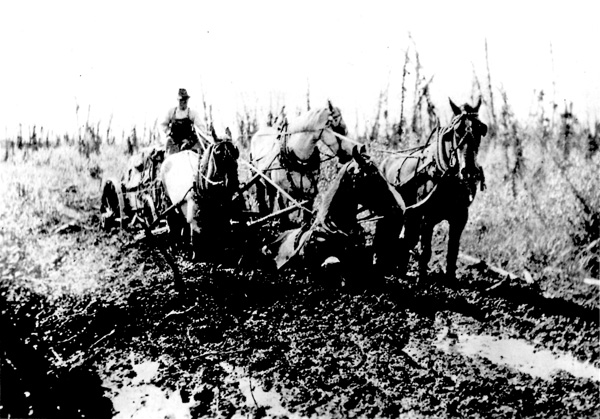
95 Mud.
(Yukon Archives.)
|
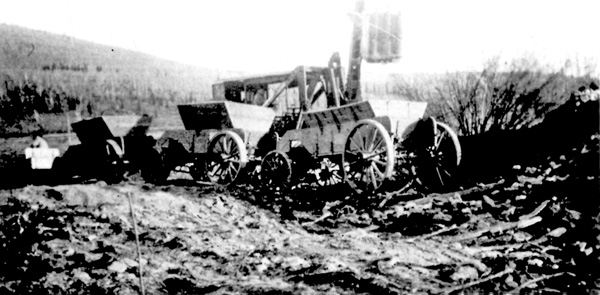
96 Road construction at Sulphur Creek, 1937.
(Yukon Archives.)
|
In the early years road builders had circumvented the problem of
permafrost by not disturbing permanently frozen ground and by ensuring
that enough insulation covered the ground to prevent melting. This was
an adequate solution so long as roads were essentially temporary and
not subject to heavy use. Such was not the case in the Mayo district,
however, and as a result, an improved technique for dealing with
permafrost was developed. The ground was allowed to thaw, the thawed
portion being then removed. Approximately three years were required to
establish the desired depth and width of the road. The same procedure
was followed in roadbed preparation, the object being a stable
foundation for the road surface. Temporary changes in soil consistency
during the thawing period made drainage a constant problem throughout
the construction phase and required much ditching.30
The introduction of motorized vehicles in the early twenties was
another factor tending toward improved roads. After 1912 an extensive
network of roads had been built by the territorial government to connect
the placer camps in the then Duncan district with the head of navigation
at Mayo.31 These roads were designed "to a standard that
would allow of wagons being used during dry weather with moderate
loads."32 While adequate to the demands of placer mining,
these roads were not able to satisfy the transportation needs of the
silver-lead industry. In 1915 the cost of freighting one ton of ore
overland from the mines to the town of Mayo was $20, compared to a
figure of $22 for transhipment from Mayo to San Francisco. Overland
shipments, moreover, were limited to the winter period exclusively in
order to take advantage of the superior road surface furnished by
snow.33 That this shipment and others like it returned a
profit in spite of the high cost of transportation was due to two
factors — the existence of extremely rich ore and the method of
hand sorting. Selected ore samples from Galena Creek taken during the
1915 season, for example, were assayed at $153.00 to $266.72 a ton and
while ore of comparable value occurred only irregularly, many deposits
showed commercial promise.34 Hand sorting, or "hand-cobbing"
as it was also called, was a simple variation of the high-grading
technique used by gold miners during the rush and entailed manual
separation of high-quality ore from that of low value for shipment to
the smelter. Nevertheless, establishing the industry on a firm
foundation demanded more than simply relying on rich ore occurrences and
the costly, time-consuming method of hand sorting. What was needed was a
breakthrough in the transportation impasse between the towns of Keno and
Mayo Landing.
It is not surprising that the first attempt to resolve this difficulty
involved a railroad. In January 1921 a company was organized to build a
railway from the junction of the Mayo and Stewart rivers to the
McQuesten, by way of Mayo River, Duncan Creek and Crystal Valley. This
scheme wrought a counter proposal from interests representing the
defunct Klondike Mines Railway to extend their line from Dawson to the
silver camp or, alternatively, to construct a railway from Mayo Landing
to the mines. Although a federal charter was secured by the former in
March of 1921, construction was never begun and, despite its intimations
to the contrary, the Klondike Mines Railway Company showed no further
inclination to take on the project.35
In light of the failure to construct a railroad and in the absence of
sufficient government assistance for road building, the Mayo district
operators were forced to confront the transportation problem on their
own. In 1922 Treadwell Yukon pressed a ten-ton Holt tractor into
service. The experiment was a marvellous success, the tractor moving
forty-five hundred tons of ore that season from the mine to Mayo
Landing. The introduction of tracked vehicles reduced transportation
costs by 75 per cent and in the words of one contemporary,
"revolutionized winter transportation in this country." Thereafter the
company shipped by tractor exclusively.36
The revolution in overland transportation presaged by the use of tracked
vehicles constituted an advance of giant proportions when it is
considered that in the same year another miner, Robert Fisher, hauled
three tons of ore from his claim to Keno City by dog team, a distance of
17 miles. Treadwell Yukon added another caterpillar to its fleet in
1923; trucks were coming into common use and the superintendent of roads
was predicting that once "objectionable grades" on the Mayo-Keno road
had been removed, shipments of 70 to 75 tons could be handled on a
regular basis.37
During the 1923 season the territorial government concentrated its
road-building efforts on the 37-mile trunk road between Mayo Landing and
Keno City. Modern construction equipment was purchased and put to use
with "encouraging results." Treadwell Yukon and Keno Hill, the two
companies which stood to gain most from its completion, contributed to
the construction of the road. While not conforming to a uniform standard
in its entirety, the road was a major factor in reducing transportation
costs. Rates on freight delivered to Keno City from Mayo were cut from
15 cents a pound in 1920 to 5 cents a pound in 1923 exclusive of freight
hauled by track-vehicles which was cheaper still. Completion of the road
also led to a substantial increase in traffic movement during the summer
months. In 1927 Atyey tractor trailers superseded wheeled carriers for
summer use with a consequent increase in carrying capacity and less road
damage. By 1928 Mayo-Keno freight rates had levelled off at one to one
and one-half cents a pound depending on quantity.38

97 Tractors on Main Street in Mayo, bound for Wernecke Camp.
(Yukon Archives.)
|
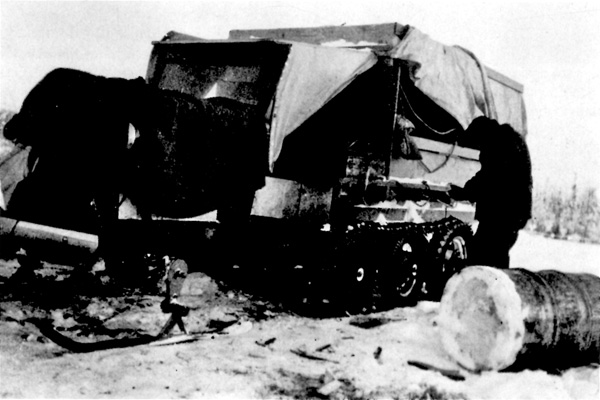
98 Coping with the Yukon winter required ingenuity. This vehicle
probably bears little resemblance to what came off the assembly
line. The front wheels have been replaced by skis, the tires equipped
with tracks and the rear tire appears to have been grooved to
help anchor the tracks.
(Yukon Archives.)
|
If the introduction of caterpillers "revolutionized" winter transport,
the installation of a concentrating mill by Treadwell Yukon in 1924 was
tantamount to ushering in the millenium.39 Essentially,
concentration accomplished the same object as hand sorting but far more
efficiently. It involved crushing the ore, then subjecting it to
processes of clarification and flotation whereby the unit weight of the
end product, or concentrate, was greatly increased in value. Some idea
of the significant savings resulting from concentration is given by data
which show that the Treadwell mill reduced ore to concentrate in the
ratio of 10:1 to 15:1.40 Simply stated, this meant that ore slated for
shipment had increased in value ten-fold while transportation costs had
remained constant; or conversely, that transportation costs had been
reduced 90 per cent. Concentration solved another transportation
problem, at least for the smaller operators. It enabled them to sell
their ore to Treadwell Yukon for treatment and receive immediate
payment, instead of waiting for the smelter returns. In an industry
where it was impossible to extract, treat, transport, smelt and get paid
in a single season and where the market price of silver-lead could
widely fluctuate from year to year, this was a positive
boon.41
Installation of the concentrator marked a radical departure from
previous attempts to deal with the transportation problem. It
demonstrated that possible solutions to the problem were not confined to
the conventional answers of the past; refining existing modes of
transportation, developing new ones and improving access routes. It
portended an increasingly sophisticated approach which saw
transportation in terms of the economic viability of the territory and
fostered a realization that whatever facilitated the movement of people,
supplies and services, whether it be the designation of a new port of
entry, a telegraph or wireless or even the selection of a new capital,
entailed a legitimate response to the transportation
problem.42
In 1930 Treadwell Yukon expressed dissatisfaction with the arrangement
whereby it had shared a portion of Mayo road construction and
maintenance costs with the government. The
change was precipitated by the government's refusal to assist in
clearing snow from one of the company's roads after a particularly
heavy storm, and a rumour to the effect that roads used by tractors
would no longer be maintained. The government's decision in this regard
was particularly surprising in view of the fact that Treadwell tractors
had carried mail between Mayo and Keno that same winter without charge
when snow had prevented the regular contractor from operating his
trucks. Additionally, the company had improved certain sections of the
Mayo-Keno trunk road on its own initiative and at its own expense.
Company roads, moreover, assisted neighbouring operators and increased
the value of adjacent properties. Livingston Wernecke, the company's
general manager, argued that the "building of all roads," including
Treadwell Yukon's, was "a true and proper function of the Government,
either Federal or Territorial" and added that by not doing so, the
government was "side-stepping one of its functions; a function that is
extremely important to a new country."43
In response to Wernecke's charge, the government conceded that it was
"very difficult to take exception to the contention that the matter of
building roads is one for the Government"; nevertheless, it held that
deferment of the royalty tax on mineral production, which had not been
imposed until 1929, demonstrated that "the Government has in every other
possible way given assistance to the mining industry in the Mayo
district."44 There the matter died, though not to the
satisfaction of Treadwell Yukon. The controversy itself is nonetheless
important. It shows that the debate over the role of the government in
northern development is not a product of the 1950s as has generally been
assumed and it offers clear proof that roads are not a newly discovered
palliative for the problems of resource exploitation in the North.
By 1920 the condition of the Overland Trail had, in Mrs. Berton's words,
"greatly depleted." "There were fewer travelers to the mining camps
now," she wrote, "for the palmy days were over."
Many of the roadhouses which in the old days had been spotted every
twenty-two miles along the winter road were closed. Passengers now had
to provide their own lunches and these were eaten in the open after
being thawed out by a bon-fire on the side of the trail. In the old days
we had made the journey in less than a week. Now the stage only made a
post a day and, if the trail was bad, the trip often took longer than a
fortnight.45
In 1921 the White Pass and Yukon Route surrendered the winter mail
contract it had held for 20 years and terminated its Overland Trail
operations. The company had initiated winter hauling in the first place
to secure the mail contract for its sternwheelers. With
the failure of the Side Streams Navigation Company in 1918, the last
obstacle to complete monopoly on the Yukon waterways was removed and
with it any competition for the postal contract. The winter contract was
taken over by Coates and Kastner in 1921-22 and later surrendered
to Greenfield and Pickering, who were superseded in turn by Richards and
Phelps during the late twenties.46
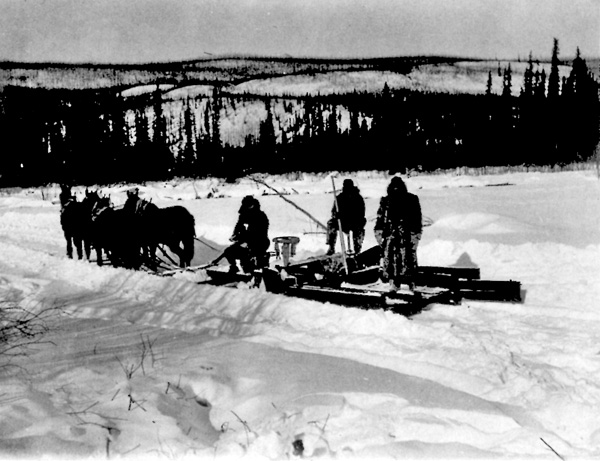
99 A road grader packs the snow.
(Public Archives of Canada.)
|
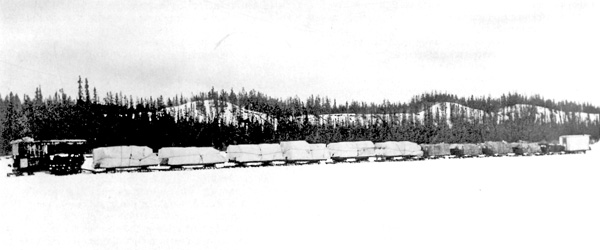
100 A supply train drawn by a power toboggan.
(Yukon Archives.)
|
In the years preceding the successful establishment of the silver-lead
industry, Dawson had been the main supply centre and distributing point
for the Mayo camp. In 1913-14 a 40-mile wagon road was built from
the mouth of Hunker Creek to Flat Creek, from which a good winter road
was built to Mayo Landing.47 In the meantime, the Overland
Trail was rerouted through Black Hills and Scroggie to serve the placer
communities that had sprung up there.48 The advent of
large-scale silver-lead production, however, underlined certain
deficiencies in the existing overland transportation system.
Consequently, the Overland Trail was again rerouted to provide direct
communication between Whitehorse and Mayo. The Whitehorse-Minto section
was left intact, but at Minto the route was diverted northeast to Willow
Creek where it crossed the Pelly River some 30 miles above the site of
the old river crossing. From Willow Creek the trail was extended to
Crooked Creek which became the terminus of the main road. From there the
trail branched off to Mayo on the east and Dawson on the
west.49
Dawson's diminishing status as a metropolitan centre with an attendant
hinterland can clearly be seen in the diversion of the Overland Trail,
but Dawson's decline was not limited to the loss of its metropolitan
function. Throughout the 1920s the Dawson area steadily lost ground as
the territory's main economic region and in 1926 it was superseded by
the Mayo district. This decline was reflected in the flow of traffic
over the Overland Trail which by 1928 was moving in much greater
quantity over the Mayo division of the Overland Trail than its Klondike
counterpart.50
Route modifications were accompanied by technological changes in the
modes of transportation. In 1923-24 trucks replaced wheeled stages
for spring and fall travel while horse-drawn sleighs gave way to
caterpillars for winter use. These improvements were initially confined
to the Whitehorse-Yukon Crossing section of the Overland Trail, beyond
which the old modes of transportation were retained. According to Mrs.
Black, caterpillar operators were limited to two-hour shifts as "the
fearful lurching of the 'cat' over the rough trail rendered it
unbearable for a driver to work" for an extended period of time.
Occasionally Treadwell Yukon assisted the regular transportation company
by freighting supplies with its own tractors between Whitehorse and
Mayo.51
Despite these cumulative improvements, one obstacle continued to hinder
traffic movement over the trail. That obstacle was the river transfer at
Yukon Crossing, which J.S. McNeill described as "the greatest drawback
on the Overland Route." While the river generally froze over in late
November, the Yukon Crossing section remained open for another month,
after which it had to be tested regularly for rotten ice. The cable
carrier that had been erected in 1916 to facilitate the transfer of
freight, passengers and mail between Whitehorse and Dawson during
freeze-up and break-up had a limited capacity and canoe transfers had to
be reinstated to handle the traffic increase resulting from Mayo.
Interdistrict overland transportation did not progress beyond the
seasonal role it had historically played during this period. The
Overland Trail was a complement to water transportation and was not
maintained during the season of open navigation. The trail fell into
disuse in the late 1930s following the inauguration of regular air mail
service. Without the mail contract "no continuous freighting service by
trail would pay" and, as a consequence, the Overland Trail was
virtually abandoned as a commercial highway.52
The depression had a twofold impact on the territorial economy which was
by no means entirely negative. The silver-lead industry was severely hit
by the crash in base-metal and silver prices although this was chiefly
felt, at least in the beginning, in a drastic reduction in ore reserves
rather than a precipitous decline in production. In its annual report
summarizing 1930, the Department of Mines noted that "an ore that was
profitable a year ago can no longer be considered as ore; the minimum
content of silver necessary for profitable operations has nearly
doubled." Before the crash Treadwell Yukon had estimated its ore
reserves to be "as great as at any time during the development of the
camp." A year later the company announced that "the ore in sight in its
properties was sufficient to last only two and a half
years."53
The smaller operators in particular were vulnerable to the vicissitudes
of the depression. Lacking the capital to increase the value of their
ore through concentration, many were forced to abandon production. For
them, development and assessment work were all that the forseeable
future held in store. A few were fortunate enough to have located on
rich properties which could be worked by hand sorting, but the
Department of Mines predicted that "production from these sources will
be very small."54
After exhausting its properties on Keno Hill in 1932, Treadwell Yukon
closed its concentrating mill and abandoned Wernecke camp. Operations
were then resumed on Galena Hill where mining continued on a much
reduced scale. In the absence of an operational concentrator, the
company was forced to resort to hand sorting which in large measure
accounts for the diminishing returns recorded from 1933 to 1936. A great
deal of effort was expended on development work during this period,
however, which resulted in the surprising discovery of an extensive ore
deposit on Galena Hill in 1936. When it is considered that this same
property was reported "exhausted" after the 1934 season, the vagaries of
mining become apparent. The company transferred its concentrating plant
from Keno Hill to Elsa in 1935 and full-scale production was resumed in
1936.55
Gold mining, on the other hand, was given a substantial impetus by the
depression. Falling prices in other sectors of the economy had the
effect of increasing the purchasing power of gold, the price of which
remained constant until 1934 when it was revalued upward by the United
States government to $35 an ounce.56 The Yukon Consolidated
Gold Corporation was completely reorganized and finally established on
a firm footing through a series of litigative actions that culminated in
the removal of A.N.C. Treadgold57 As a consequence,
full-scale systematic production was resumed after an hiatus of some 20
years with the result that in 1933 the Klondike regained its primary
position in the Yukon economy.58
Despite the re-emergence of the Klondike and the transfer to Galena Hill
by Treadwell Yukon, few roads of any consequence were built during the
1930s. A road was constructed between Keno Hill and the Silver King claim
group on Galena Hill, while in the late thirties work was done on a road
connecting Dawson with the Alaska boundary near Eagle, Alaska. Most of
the activity of the territorial roads department was directed toward
maintaining or improving existing roads, a sizeable task in
itself.59
This did not silence the persistent Yukoners for whom roads were a
universal panacea. "What my constituents are more interested in,"
George Black declared, "are roads, for in so vast a country transport
is a vital problem." During the late thirties some federal funds were
made available for road building as part of a national public works
programme, but this failed to satisfy the insatiable appetites of those
in the Yukon who saw at the end of every roadway the proverbial pot of
gold.60
III
Before the rise of lode mining, the region tributary to the upper
Stewart River had been little more than an outpost of Dawson.
Transportation routes, water as well as overland, had originated at
Dawson and the entire Mayo area had been supplied by trading and
transportation companies operating out of the then territorial capital.
During the first decade of the century, two sternwheelers,
the La France and the Prospector, owned by the Stewart
River Company, had made the run between Dawson and Mayo Landing carrying
passengers, freight and mail. Although the company continually reported
a loss at the end of each season, it persisted until 1909 when the
Stewart River trade was taken over by the Side Streams Navigation
Company. The Side Streams Navigation Company furnished weekly service
between Dawson and Mayo, a distance of 238 miles, during the open season
of navigation which generally ran from 20 May to 1 October. Freight was
delivered to Mayo Landing at a rate of two cents a pound. The Side
Streams Navigation Company survived until 1917 when it too succumbed to
the pressures of extended supply lines, a small market and insufficient
revenues.61
The British Yukon Navigation Company extended its operations to Mayo in
1918. Although Taylor and Drury of Whitehorse ran the Thistle,
and later the MV Yukon Rose, to supply its widely scattered
trading posts, the British Yukon Navigation Company now enjoyed complete
control over the Yukon waterways since Taylor and Drury was not a common
carrier. Moreover, with the exception of Carmacks and Mayo, where Taylor
and Drury had trading posts, the Thistle, and its successor, the
Yukon Rose, worked rivers such as the Hootalinqua, the Pelly and
the White in which the British Yukon Navigation Company had no interest.
In this respect Taylor and Drury played an important role which was a
throwback to pre-gold-rush days when trading and transportation
functions were frequently merged in one company, thereby enabling
transportation to be provided in remote areas.62
The expansion of the White Pass and Yukon Route into the Stewart River
region did not immediately diminish that region's dependence on Dawson.
Even after the establishment of the silver-lead industry in 1921,
Dawson remained a major funnelling point for river traffic into the Mayo
district.63 Until 1923 when the bulk of this traffic was
transferred to the upper river, bagged ore from the Mayo mines was
shipped downriver to Alaska for transhipment to a smelter in the United
States.
Most of this freight was handled by the American Yukon Navigation
Company, an American-registered subsidiary of the White Pass and Yukon
Route.64 Although the company made occasional trips to Mayo,
its operations were primarily confined to the lower river. As a general
rule, the ore was picked up at Stewart Landing or Dawson after having
been dropped by the company's sister subsidiary, the British Yukon
Navigation Company. "Improvisation was the important thing," a
company official explained. "What could be done with the boats
available, water conditions etc. were factors that had to be taken into
consideration."65
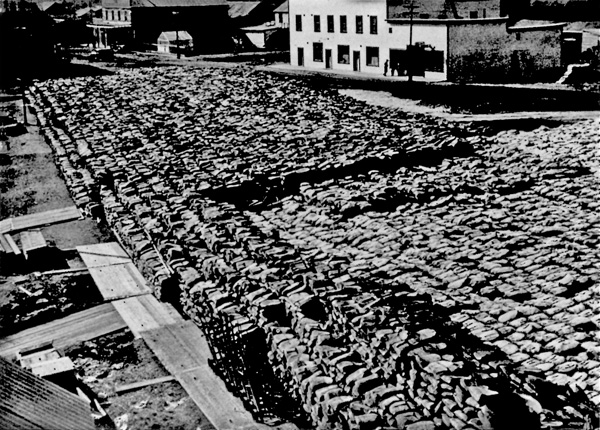
101 Thousands of bags of ore concentrate await shipment by boat
from Mayo.
(Photo by J. Dunn.)
|
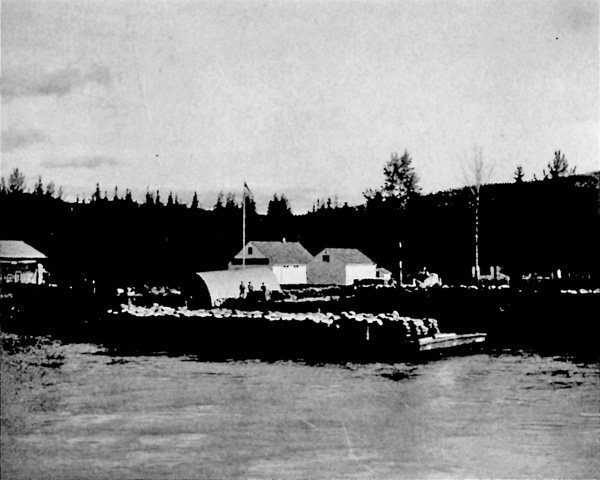
102 The barge Ibex, loaded with concentrate, waits at
Stewart Landing to be transported to Whitehorse.
(Source unknown.)
|
In its annual report on mineral production for 1921, the Dominion
Bureau of Statistics reported that "complete development [of the Mayo
deposits] would of course be obtained by linking up the mining area with
the White Horse Pass [sic] and Yukon Route at
Whitehorse.66 The bureau was not alone in recognizing the need
for a shift away from Dawson. The transportation company was cognizant
of the deficiencies of the existing water route. Landing facilities at
Dawson were so poor that it was often impossible to dock loaded vessels
at low water. The waterfront area was congested with silt from dredging
operations on the Klondike River. This was exacerbated by an eddy on the
right limit of the Yukon River that encouraged silt accumulation and
prevented the normal wash of the current from dispersing the sediment.
Extending the wharves was not feasible because of the danger of ice
damage during the spring break-up. Since no long-term solution was foreseen
and as dredging the waterfront was never seriously considered, the
British Yukon Navigation Company was forced to take action of a
temporary and continuing nature. On or about 15 August of each year
during a period of low water, the company would withdraw certain of its
sternwheelers from service and use them to sluice out the reservoir of
sediment with their paddle-wheels, a procedure that was then repeated
every few weeks until the end of the navigation season. This was not
entirely successful, however, as the sluicing paddlewheels tended to
leave deep holes in the riverbed, thereby creating new pockets for the
silt to accumulate.67
In spite of these drawbacks, most of the ore was shipped via Dawson
until 1923. Although the Mayo-Whitehorse waterway was substantially
shorter, the White Pass and Yukon Route assumed that "it would be
impossible to send this ore up to Whitehorse from the mouth of the
Stewart River as the Yukon [River] above Dawson to Whitehorse was a much
swifter stream than below Dawson. The development of a barge
specifically designed for swift-water use, however, enabled the company
to establish regular river service between Mayo and Whitehorse with
connecting rail service to Skagway in 1923.68 In the meantime, the
American Yukon Navigation Company had curtailed its operations on the
lower river. The completion of the Alaska Railroad from Seward to
Fairbanks in 1922 by the United States government caused the American
Yukon Navigation Company to suspend its Dawson-Saint Michael operation
in exchange for a quid pro quo whereby the United States government
refrained from running boats into the Yukon Territory from
Nenana.69
The change in transportation routes occasioned by the transfer of Mayo
traffic to the upper river had a serious impact on Dawson. Coupled with
the competition arising from the Alaska Railroad,
tonnage through Dawson decreased to such an extent that after 1923 the
American Yukon Navigation Company maintained only one sternwheeler on
the Dawson-Nenana run. This vessel was primarily engaged in moving ore
not handled on the upper route and did not maintain a regular schedule.
In 1923 the company reported a net operating loss of fifty thousand
dollars. The following year the general manager of the White Pass and
Yukon Route minced no words in describing the business outlook in Dawson
as "bad," appending this observation with a request for a drastic
reduction in waterfront leases under a veiled threat of pulling out of
the city if the request were not granted.70 Unfortunately for
the company, no immediate relief was obtained, but, despite its threat,
it carried on.
While continuing to function as the territory's main highway of trade
during the twenties and thirties, the Yukon River became increasingly
dependent on one of its tributaries, the Stewart River, for the vital
infusion of products — silver-lead ore from the Mayo mines —
required to sustain that trade. The Stewart, a 320-mile stream rising in
the headwaters of the Mackenzie Mountains, conformed to the pattern
established by other northern and eastern tributaries of the main
watercourse in that it was fed by precipitation rather than glacial
melt.71 This peculiar condition made through-navigation
between Mayo Landing and Whitehorse impossible for all practical
purposes as high- and low-water levels were not uniformly distributed
throughout the Stewart-Yukon system. Because of this phenomenon, the
British Yukon Navigation Company handled traffic between Mayo and
Whitehorse in two stages. Bagged ore from the mines was loaded onto
sternwheelers and barges at Mayo and conveyed to Stewart Landing where
it was transhipped by vessels on the regular Yukon River run. During
late May and early June when the Stewart reached its highest level, the
company assigned its larger boats to the task of moving as much ore as
possible between Mayo and Stewart Landing. That ore which was not
immediately transhipped was stockpiled until the Yukon River achieved
sufficient depth, generally after 1 July, to permit backlog shipments
to the railhead at Whitehorse.72

103 The SS Keno winching off a bar with a "walking stick"
or spar. Designed for the Stewart River trade, the Keno
was built in 1922. Its hull was rebuilt in 1937. The recess in
the boat deck gave the wheelman an unobstructed view for the
for'deck and the river and was originally required because the
Keno's hull was short in relation to its housework.
(Public Archives of Canada.)
|
A shifting navigation channel and prolonged periods of low water,
each characteristic of the Stewart River, underlined the need for a
specially designed vessel capable of operating within the limitations
imposed by the river and able to meet the transportation demands of the
lode-mining industry. These requirements were in large measure satisfied
by the construction and launching of the SS Keno in 1922.
Designed especially for low-water use, the Keno was a
single-stacked sternwheeler 130.5 feet long and 30 feet wide. It had a
very light draft, an essential criterion for Stewart River operations.
Although it had facilities for 32 passengers, the Keno was
primarily a cargo hauler. When water ran high on the Stewart, the vessel
was transferred to the Hootalinqua River or Teslin Lake. During the 1924
season, the British Yukon Navigation Company operated the Keno
and two sister ships, the Canadian and the Nasutlin, on
the Stewart River, as well as two gas-driven motor launches, the
Hazel B and the Neecheah. By 1928, however, the river was
served almost exclusively by the Keno.73
The use of smaller sternwheelers on the Stewart River was only one
phase in a continuing battle between the British Yukon Navigation
Company and the river. Riddled with rocks and bars, the Stewart remained
a difficult river to navigate despite the utilization of the
Keno. Until the end of the steamboat era in the territory, the
Stewart was considered much harder to navigate than the Yukon. Some
skippers actually preferred the Stewart to the Yukon because of the
constant challenge it presented; however, deck-hands were almost
unanimous in their condemnation of it and many eyed their Yukon River
counterparts enviously. According to G.B. Edwards, the general manager
of the White Pass and Yukon Route, 14 sections of the river between
Mayo and Stewart Landing required lining, making "it necessary to reduce
the cargoes down to a mere trifle." In 1922 the territorial government
received a request to construct lining cables at various locations and
to remove the most menacing boulders on the watercourse. Later that
year, improvement work was undertaken on the 20-mile stretch of river
west of Mayo entailing rock removal, buoying sandbars and taking
soundings. In 1923, cables were installed to facilitate navigation at
Twentysix Mile Bar, Jackman's Chute, Long Line Bar, the lower end of
Long Line Bar and five miles above Porcupine.74
By 1929 the territorial economy had expanded into the upper Stewart
region. This region, situated north of the Stewart River above Mayo, was
an important centre for exploration, prospecting and trapping. The Mayo
district derived much of the timber required for its mining operations
there and the region was an important mineral area in its own right
because of the Beaver River silver deposits. While the possibilities of
the upper Stewart were variously described as "many" and "promising,"
access was difficult. Two sections of the Stewart River, the only water
route into the region, were particularly formidable. Fraser Falls, 43
miles above Mayo, effectively blocked all further sternwheeler
navigation. A half-mile portage was required to get above the falls
where supplies were transferred to small motor launches for the balance
of the journey. Although a tramway was proposed to facilitate the
handling of goods around the falls, it was never constructed. At
Three Mile Rapids, so named because they were located three miles above
Fraser Falls, the launches had to be tracked through. In the spring of
1935 the rock formation on the left limit of the rapids was blasted and
removed, thereby enabling the boats to negotiate the rapids under their
own power.75 Despite these improvements, river navigation
remained an arduous undertaking; in fact, the upper Stewart country
holds the unique distinction of being the only place in the territory
where overland transportation was not markedly inferior to river
transport before 1950.
Many of the improvements to the Yukon River in this period were made in
response to the demands of Mayo industry. Low water during May and June
impeded the movement of silver-lead ore, disrupting through transport
between Mayo Landing and Whitehorse. To a large extent the product of
the Yukon's glacier-fed tributaries, this low-water condition was
exacerbated by the slow break-up of shore ice on Lake Laberge. Shallow
flats at the upper end of the lake were also a factor in delaying the
opening of navigation. As early as 1916, Herbert Wheeler, an employee of
the White Pass and Yukon Route, had recommended that a channel be
dredged through the flats in order to advance the opening of the
navigation season. But his proposal, coming as it did before the
silver-lead industry had been established, lacked sufficient urgency to
be taken up.76
With the beginning of large-scale extractive operations during the early
twenties, a solution to the problem of low water became urgent.
Believing "that unless something could be done... the development at
Mayo would be retarded," the British Yukon Navigation Company
constructed a dam seven miles below Marsh Lake in 1925. Consisting of a
submerged weir with flashboard, the dam was built at a cost of $160,000,
the entire sum being borne by the White Pass and Yukon Route. At the end
of each navigation season when the rivers and lakes above the dam were
close to their high-water levels, the dam was closed. A minimum flow was
maintained throughout the winter for domestic use and fire control in
Whitehorse. Designed to retain a 13-foot head at the site, the dam
created a winter reservoir extending back to the southern end of Bennett
Lake that was five feet above dead low water. After 1 May the dam was
progressively opened to flush out the ice on Lake Laberge and to raise
the level of the Yukon River. An outstanding success, the dam effected a
20 to 25 per cent increase in the carrying capacity of the Yukon River.
It advanced the navigation season by some three weeks at a most
propitious time, when long hours of summer sunlight permitted 24-hour
operation of the river boats, enabling at the same time the first boats of
the season to carry full loads.77
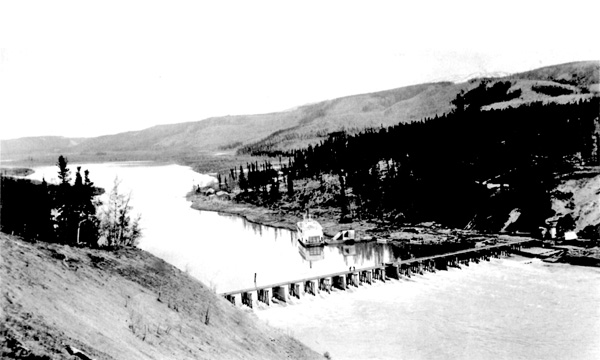
104 The British Yukon Navigation Company dam at Marsh Lake.
(Yukon Archives.)
|

105 The lampblack trail on Lake Laberge.
(Photo by W. Bamford.)
|
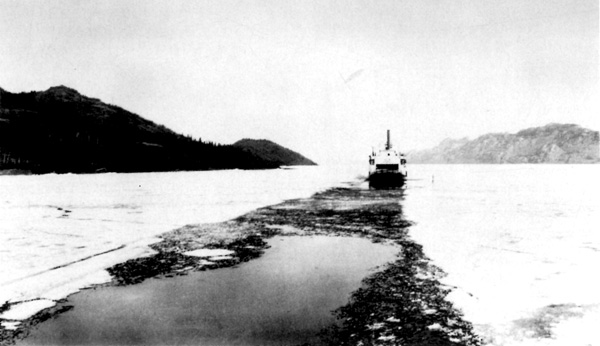
106 The steamer Casca plows through the lampblack trail.
(Photo by W. Bamford.)
|
Another technique developed by the transportation company to hasten the
melting of ice on Lake Laberge consisted of spreading a mixture of
carbon black, old crankcase oil and diesel oil in a series of strips
across the length of the lake. The mixture was sprayed from the back of
a truck, the operation being so timed that the application was done in
clear weather and while the ice was still solid enough to support the
truck. The expediency of the technique depended, Wheeler later recalled,
"on whether we get a heavy fall of snow after it has been spread or
whether we get continuous clear weather with consequent sunshine," as
surface snow inhibited the melting action of the sun upon the mixture.
Despite this measure of unpredictability, the treatment was capable of
opening a channel through three feet of ice under optimum climatic
conditions.78
Navigation channels on the Yukon River were modified annually by the
movement of gravel, silt and rocks during the spring break-up. At the
beginning of each operating season the company would employ two small
gas boats, the Sibilla and the Loon, to chart the most
navigable channels on the waterway. Where necessary, the riverbed was
raked or scraped to open clogged or closed channels. In 1928, for
example, the channel through Hellsgate was scraped with a dragline
powered by a donkey engine. While this method achieved satisfactory
results, it was costly, provided temporary relief only and caused
serious delays to passing sternwheelers, Pile and rock dams designed to
divert water into the main channel proved inadequate as well, as the
water tended to cut around the ends of them.79
In addition to regular improvement work, the company employed
artificial means to control the flow of traffic over the river. This was
done with a commodity- and class-rate system designed to stimulate or
retard the movement of freight as conditions demanded. During periods
of low water when heavy freight could not be shipped and thus entailed
storage in the company's Whitehorse warehouses, high class rates were
applied to discourage shipments. The opposite was true of course during
high-water periods when commodity rates were in
effect.80
As far as the British Yukon Navigation Company was concerned, the best
available solution to the channel problem was to dredge out as permanent
a channel as possible on the Yukon and Stewart rivers. In 1929 the
territorial authorities, cognizant of potential competition for Mayo
traffic from Alaskan ports, requested a grant from the Department of the
Interior to finance a dredging project, warning the department that
"unless navigation on the upper river is improved... a large portion of
this traffic will eventually go down the River to Alaska." After
consulting the Department of Public Works, which declined to fund the
project, the Department of the Interior notified the gold commissioner that no
assistance could be expected from Ottawa.81
In return for constructing the Marsh Lake dam, the British Yukon
Navigation Company received an annual grant from the territory to
defray the cost of general improvement work on the Yukon's navigable
rivers.82 The company considered the grant to be "niggardly,"
noting that more money was spent on the less-travelled Stikine. As the
territory's sole transportation company, the White Pass and Yukon Route
felt that it understood the transportation needs of the Yukon better
than anyone else. Such government-sponsored schemes as the
Carcross-Whitehorse road, which ran almost parallel to the railway, were
viewed with a considerable degree of skepticism when the waterways
demanded so much attention.83 The company had a vested
interest in seeing government money expended on navigation improvements
as overland transport, owing to the increase in motor vehicle use, was
becoming progressively more competitive with river transport,
especially on certain types of goods.
Barges, the primary mode of conveyance for Mayo ore, contributed to
the high cost of shipping. Company officials estimated that pushing a
barge added 50 per cent to a sternwheelers operating time with a
consequent increase in fuel consumption.84 In an attempt to
reduce barging on the Stewart Landing-Whitehorse section of the Yukon
River, Herbert Wheeler, the president of the White Pass and Yukon Route,
and Bert Fowler, the shipyard foreman, designed a sternwheeler that
could carry three hundred tons, a greater freight-carrying capacity than
any other boat on the upper river. Constructed in the company's
Whitehorse shipyard and christened the SS Klondike, the new
sternwheeler was launched in 1929. The Klondike, 210.25 feet long
with a 42.1-foot beam, was, like its sister ships, a light-draft
craft.85 Although many of its mechanical fittings had once
seen service on other Yukon river boats, two features which made the
Klondike unique on the upper Yukon were a specially designed hull
which fed a maximum flow of water into rather than around the
paddlewheel and compound condensing engines. The former modification
permitted efficient wheel-blade operation in shallow water even when the
Klondike was operating at full capacity.86
The Klondike performed ably. From Stewart Landing, where
silver-lead ore was hand-trucked onto the Klondike's cargo deck,
the upstream run was completed in the same time as a sternwheeler
operating without a barge.87
The 1930s were difficult years for the British Yukon Navigation
Company. The collapse of silver-lead production, reaching a low of 110
tons in 1935, led to drastic decline in transportation revenues.
Although gold production was increased substantially after 1932, the
transportation requirements of the Klondike district remained relatively
static. In an effort to reduce operating expenses, the company conducted
experiments with coal-fueled boilers; however, boilers did not function
well with this type of fuel and, as a consequence, wood-burning systems
were retained.88

107 Steamer Aksala and barge approaching Five Fingers
Rapids on the upstream run.
(Photo by S. White.)
|
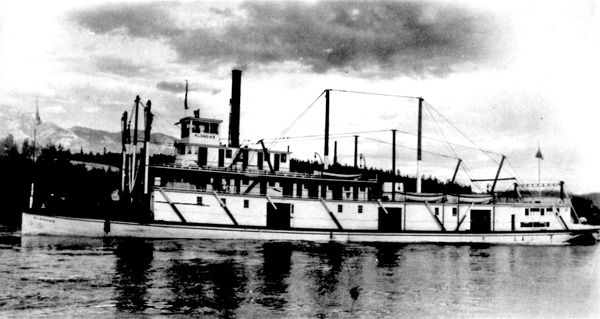
108 SS Klondike No. 1, 1929. The Klondike's
housework was kept to a minimum, all emphasis being placed
on cargo capacity without sacrificing shallow draft.
(Public Archives of Canada.)
|
In 1936 the company suffered a severe blow when two of its
sternwheelers, the Klondike and the SS Casca, were
wrecked. Fortunately, the disaster occurred at a time when silver-lead
production was at an extremely low level, thereby diminishing the impact
of the loss on Mayo shipments. Both were rebuilt in 1937,
Klondike No. 2 being slightly smaller than its predecessor. White
Pass officials have since maintained that reconstruction costs placed a
serious strain on the company's resources and that this, combined with
manpower and material shortages during the late thirties and the Second
World War, prevented the company from properly maintaining its
sternwheeler fleet. Interviews conducted with shipyard personnel lend
little credence to this claim, however, and the annual reports filed by
the steamship inspector leave no doubt as to the worthiness of operating
British Yukon Navigation Company boats.89
Between 1914 and 1939 the Yukon transportation system retained its
intimate association with the navigable waterways. Although the time
had long since passed when the movement of freight was confined to the
summer months, a seasonal pattern to transportation persisted that was
directly attributable to a dependency on water routes. The location of
supply centres and distributing points, moreover, continued to be
determined in large measure by their proximity to main water routes as
is evident from the following exchange. In 1923 a proposal was put forth
to relocate the office of mining recorder from Mayo Landing to Keno
Hill, the centre of extractive operations for the entire district. In
refusing to counsel the move, the Northern Affairs Branch of the
Department of the Interior cited as its main objection the fact that
"[as the Stewart] river is the general means of communication in this
district it might be a mistake to remove the office from the river and
from the point at which transhipment of ore is taking
place."90
The most important single factor governing water transport between
the wars was mineral production from the Mayo district. The demand for
transportation created by the lode-mining industry sustained the British
Yukon Navigation Company through what was otherwise a very difficult
period. As a revenue-producing source, moreover, silver-lead ore was far
superior to gold. Whereas one ton of silver-lead ore or concentrate was
equal in value to an estimated four to five ounces of gold, the return
to the transportation company on the latter was negligible in comparison
to the revenues realized from shipping the products of the Mayo mines.
Tonnage statistics recorded by the White Pass and Yukon Route show that
on the average twice as much freight was handled between Mayo and
Whitehorse than between Whitehorse and Dawson during those years when
the Mayo mines operated at or near capacity.91 As one writer
has noted, "without the Treadwell mine contract the regular sternwheeler
schedule would have been reduced to occasional supply runs to
Dawson."92 Mayo industry and the British Yukon Navigation
Company were mutually supportive. Neither could have functioned without
the other. Just as the transportation company was dependent on
silver-lead for vital revenue, so was the mining industry dependent on
the river facilities of the British Yukon Navigation Company for getting
its ore to the smelter.
But this dependence on water transport had many limitations. The
seasonal nature of river navigation forced Treadwell Yukon to maintain
on-site inventories that were far larger than those stocked by
comparable silver-lead producers operating in Quebec and British
Columbia.93 Because the transportation season was confined to
5 months of the year, the company often had to wait a full 12 months
before returns from the previous year's work were received. As a
consequence, investments in working capital were necessarily large with
attendant high interest charges. The instability of silver-lead prices,
which were subject to wild fluctuations on the market, meant that local
producers operated under the added burden of never knowing what they
would receive for their ore. Water transportation was deficient in
another very important respect. It precluded speculative production
increases on the basis of market trends. In August 1929, for example,
the territorial gold commissioner, G.I. MacLean, wrote that "if we had
adequate transportation the output [from the Mayo mines] would be very
materially increased, but when the White Pass can only handle a certain
tonnage each year, there is no advantage in increasing the output beyond
that figure."94 Ironically, the collapse in silver-lead
prices that was just around the corner would have deterred production
increases anyway. Nevertheless, MacLean's statement clearly underlined
one of the basic drawbacks of water transport — its inability to
adjust to rapid and substantial changes in demand.
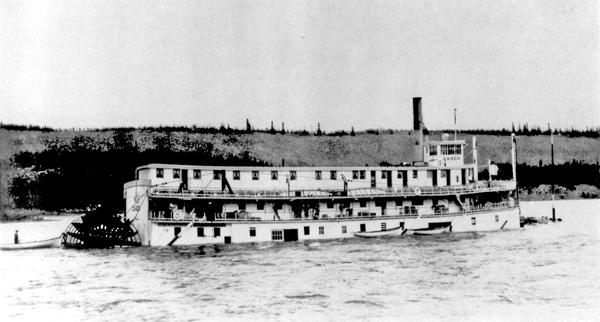
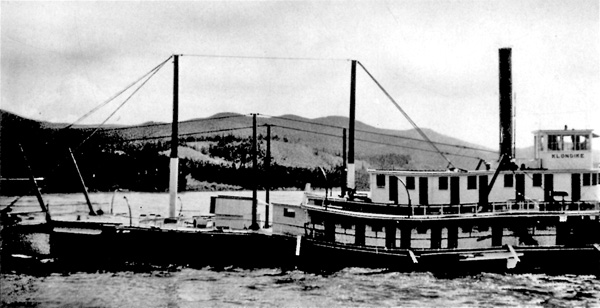
109-110 In 1936 the British Yukon Navigation Company lost Casca
No. 2, which foundered in Rink Rapids (Fig. 109) and Klondike
No. 1, which hit a rock five miles below the confluence of the
Yukon and Hootalinqua (Teslin) rivers (Fig. 110).
(Photos by
J.J. Forde and from the Maritime Museum, Vancouver.)
|
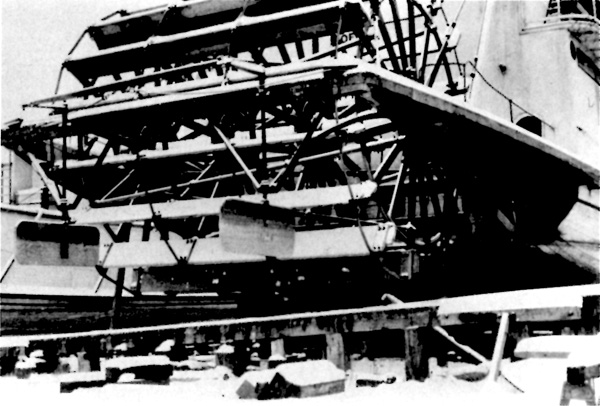
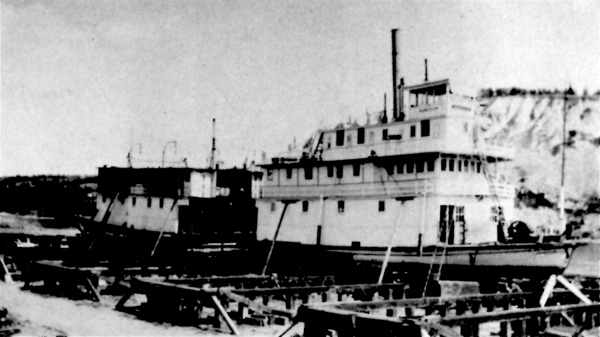
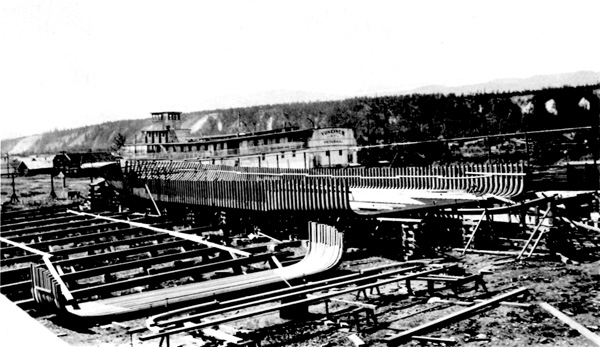

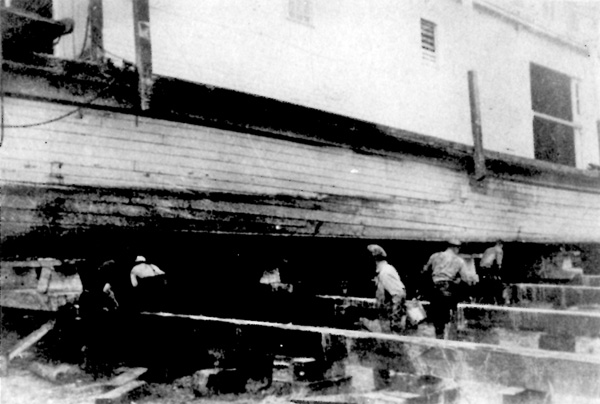
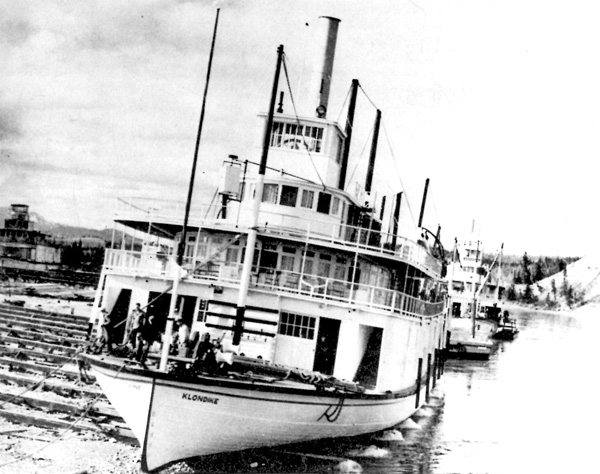
111-116 The shipyard at Whitehorse. 111,
The wheel of the Aksala. (Photo
by R. Kingston.) 112, To enlarge the
Nasutlin, boatwrights cut it in half and added a middle section.
The shipyard crew called it the "Nasutlin stretch." (Photo by S. Smith) 113, The building of Klondike No. 2. The
boiler from the steamer Yukon) (background) was used in
Klondike Nos. 1 and 2. (Photo
by S. Smith.) 114, A crew removing ice
from the spillways. (Photo by W.
Crawford.) 115, To launch the boats in
spring, "butter boards" were fitted to the ways and the boats were
lowered onto these from cribs. Tallow was then liberally applied to the
ways. (Photo by H. Perchie.) 116, When the signal was given, the boats were
launched. (W. Bromley
Collection.)
|
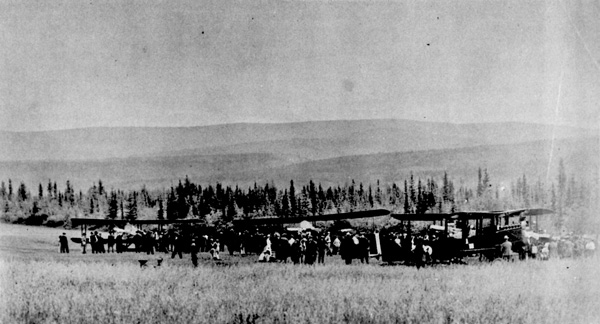
117 Alaska Air Expedition planes in Dawson, 17 August 1920.
(Public Archives of Canada.)
|
IV
While the era of the dog sled and canoe had long since passed into
history, no new advance in Yukon transportation had ever overcome the
twin handicap that was as old as Yukon transportation itself; extended
supply lines and slow modes of travel. During the 1920s this twin
handicap was effectively challenged by an entirely new form of
transportation — the airplane. Unlike other forms of transportation
such as the sternwheeler, the railroad and the automobile, the airplane
found its first Canadian civil application in the North.
The North's unique role in the early history of Canadian aviation was
in large measure the product of a fortunate set of circumstances.
Postwar demobilization had left the country with a large surplus of
aircraft totally "unsuited to inter-city traffic either for passengers
or goods," but easily "adapted both to the conditions and needs of
aviation in the north." The North abounded in lakes and rivers that
provided ready landing sites for ski- and pontoon-rigged aircraft except
for those periods when the ice was forming or breaking up. These natural
landing facilities were crucially important during the pioneer phase of
development as man-made landing strips were economically
unfeasible.95
Much of the early interest in northern aviation originated with the
Canadian government. Following the war, the government conducted an
extensive inquiry into the potential of air transport in the North. The
response of several mining companies and a number of government
departments was favourable enough to justify further study with the
result that the Canadian Air Board was established in 1919. During its
brief existence the board did much to foster the development of northern
aviation through such undertakings as its aerial survey programme.
Unfortunately, the Department of National Defence, which assumed
responsibility for aviation when the board was abolished in 1923, was
less attuned to the northern possibilities of the airplane and
government interest in promoting northern aviation soon
diminished.96
Despite the government's early encouragement of northern aviation,
the first airplanes to reach the Yukon were not Canadian but those of
the First Alaska Air Expedition, an American-sponsored venture to
determine the feasibility of establishing an air route between Alaska
and the United States. Consisting of four, two-seater De Havilland 4Bs
piloted by eight U.S. Army Air Corps pilots, the expedition left New
York on 15 July 1920 for Nome, Alaska. On 16 August the planes made a
scheduled stop at Whitehorse, thereby becoming the first aircraft to
land in the Yukon territory. A day later they flew on to Dawson where
they were greeted by an exuberant crowd and the commissioner of the
territory, G.P. Mackenzie.97
The local inhabitants were quick to grasp the significance of the
expedition. They recognized that the airplane represented a practical
solution to their isolation. The air, unlike the rivers, the roads and
the railroads, provided an unlimited medium of travel free of shallows,
narrow channels, ice, grades, permafrost and drainage. At Dawson the air
corpsmen presented the commissioner with a petition from the citizens of
Whitehorse. The petition expressed the "fervent hope that our Government
will keep pace with other countries in the establishment of a regular
aeroplane service throughout our Dominion and especially in the Yukon
where it is so much needed."98
Despite these very significant early advances, six years were to elapse
before air transport was established in the territory. The abolition of
the Canadian Air Board brought to an end the government's early interest
in aviation's northern orientation. In the interim, however, a variety
of small airlines continued to operate in the northern regions of the
central and prairie provinces with the result that the design and
technology of the airplane were rapidly improved. By the mid-twenties
aircraft with closed cockpits or cabins, high wings, air-cooled radial
engines and adaptable landing gear had been developed that were
well-suited to the conditions of northern flying.99
The first company to offer commercial air service in the territory was
the Whitehorse-based Yukon Airways and Exploration Company. Organized
in 1926 by a group of Mayo district and Whitehorse businessmen, Yukon
Airways commenced operations in the spring of 1927. The company's first
aircraft was a Ryan monoplane, appropriately named Queen of the
Yukon. The Queen had a payload capacity of twelve hundred
pounds or five persons and flew the Whitehorse-Dawson-Mayo circuit with
occasional side trips to Keno.100
Plagued by personnel problems, a lack of capital, crashes and poor
management, Yukon Airways succumbed in 1929. Its assets were taken over
by a group of Mayo district miners and businessmen and a new company
was incorporated in May of 1929 which retained the name of its
predecessor.
Prospects for the new company dimmed perceptibly when within the brief
span of five and one-half months it lost two of its three planes. In an
attempt to recoup, the owners appealed to the minister of the Interior
to rebate the $9,000 duty paid on the aircraft and requested the
short-term loan of a pilot and plane. During the negotiations with the
department the company lost its third plane and when the department
failed to proffer assistance, Yukon Airways was compelled to terminate
its operations.101
Despite the formidable problems associated with these early attempts to
establish Yukon aviation, the airplane had performed well enough to
justify a confident appraisal of its future role in the territory's
economic development. The mineral industry in particular was cited as a
potentially major beneficiary. As G.I. MacLean, the territorial
commissioner, wrote,
the airplane will... [enable] prospectors to
reach locations in a few hours and get down to a good season's work,
whereas, under present conditions practically all their time is consumed
in getting in and out of these places during the season of open navigation, and
therefore, they are to all intents and purposes inaccessible. It will
also be a great factor in providing rapid transportation for mining
experts and others who may wish to make a trip into the country, and
who could not spare the time occupied in travelling under present
conditions.102
The first local company to use the airplane for prospecting was
Treadwell Yukon. The company acquired a five-seater Fairchild monoplane
in 1928. This aircraft was an all-season vehicle equipped with
pontoons, wheels and skis. The following year another aircraft, a De
Havilland Moth biplane, was purchased. During the 1929 season Treadwell
Yukon prospected the Snake and Peel river regions. According to O.S.
Finnie, director of the Northern Affairs Branch of the Department of the
Interior, Wernecke would fly his men into designated prospecting zones,
leave them there for upwards of a month and then return with additional
supplies and transfer them to another area. In 1929 the "Fairchild and
Moth planes made 263 flights, flying 358 hours and covered 31,240 miles
of territory. They carried a total of 131 passengers, 11,351 pounds of
express and 10,877 pounds of mail." For his pioneering efforts on
behalf of Yukon aviation, Martha Black later wrote that Wernecke should
be credited "in no unstinted measure" with the "foresight, the planning
and use of the plane."103
There has been some confusion concerning the operation of two companies,
each of which bore the name Klondike Airways. The name Klondike Airways
was originally adopted by Greenfield and Pickering, the winter mail
contractors on the Overland Trail, and subsequently used by Richards and
Phelps who succeeded Greenfield and Pickering in 1929. In both cases the
name Klondike Airways was used to describe one aspect of a
transportation service provided by these companies; it did not, as the
name implied, connote ownership of aircraft.
Greenfield and Pickering's decision to use the name Klondike Airways can
be traced back to late February of 1928 when Pickering announced that
if the company's winter mail contract were extended for four years, the
company would purchase two airplanes and operate them "when business
and weather conditions permitted." This last stipulation applied to
freeze-up and break-up when the Overland Trail was unsuitable for
tractor use. The airplanes were never purchased, however, and
subsequent arrangements were made with Treadwell Yukon to lease one of
that company's planes. In October 1928 a notice appeared in the
Dawson Weekly News informing the public that Greenfield and
Pickering had contracted the Treadwell Yukon Fairchild and that
"scheduled mail and passenger flights between Dawson, Mayo and
Whitehorse would commence immediately.104
Greenfield and Pickering surrendered the winter mail contract and
terminated their Overland Trail operations in 1929. On 12 February 1930
a second company, also named Klondike Airways, was incorporated under
the directorship of T.C. Richards and W.L. Phelps of Whitehorse.
Richards and Phelps continued the arrangement initiated by Greenfield
and Pickering whereby a plane was leased from Treadwell Yukon to
transport mail, passengers and express during those periods when the
Overland Trail could not be used. Although the Register of Canadian
Civil Aircraft (September 1928) lists a Fairchild and a De Havilland
Moth under W.L. Phelps's name, these aircraft were owned by Treadwell
Yukon. Phelps's name was used because he was Treadwell Yukon"s attorney
and resident Yukon agent.105
In retrospect, the late twenties and early thirties can be seen as a
period of difficult gestation in the history of Yukon aviation. As G.A.
Jeckell, the territorial comptroller, later recalled, "at this time
there were practically no landing fields in the Yukon, and none of any
size, landings being made mostly on river bars, outside of a field at
Whitehorse. Summer and winter flying were not adversely affected as
most of the early aircraft were equipped with pontoons or skis, but
wheel-rigged planes required on-land facilities, for which river bars
were little more than a temporary and inadequate substitute. The
provision of landing fields posed two distinct problems. The existence
of permafrost made the construction of stable as well as level landing
fields difficult, while the demand for on-land facilities was too small
to underwrite the capital cost of airstrip construction. Consequently,
the risk factor was increased at the same time as the operational
efficiency of the airplane was diminished because short, rough fields
and bars retarded the necessary ground speed required for maximum load
take-off.106
Between 1927 and 1930, fields that can best be described as makeshift
were laid out at Whitehorse, Dawson, Mayo and Keno. Another field was
built near Minto at the junction of the Overland Trail to serve as an
emergency landing facility for planes operating between the territory's
main population centres. Like so many other aspects of Yukon
transportation, no clearly defined procedures governed the financing
and selection of territorial airfields before 1940. More often than not
the various companies engaged in aviation assumed much of the burden,
relying on the territorial government to later reimburse them. This was
a sensible, if not entirely satisfactory, approach given the nascent
state of aviation. Exclusive private control was consciously avoided,
however, as any attempt to charge tolls would, in Wernecke's words,
have made the company concerned "about as popular as a skunk at an afternoon
tea."107
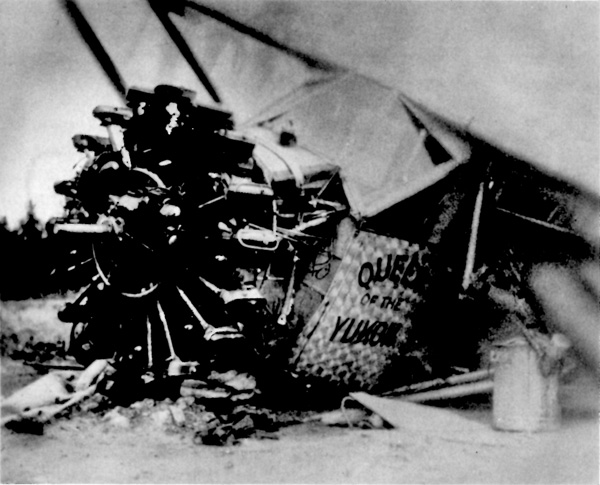
118 Yukon Airways and Exploration Company's Queen of the
Yukon after crash.
(Public Archives of Canada.)
|
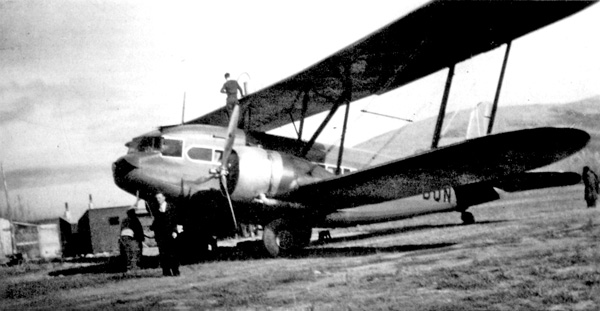
119 British Yukon Aviation Company's Curtis Condor taking
on fuel at Mayo airfield.
(Yukon Archives.)
|
While pontoon-rigged aircraft were left untouched by the question of
airfields, their dependence on water for take-off and landing posed
certain specific problems. Water take-offs required wind assistance, and
Jeanne Harbottle, whose husband was one of the Yukon's pioneer airmen,
has recalled the "hours spent on a calm lake waiting for enough wind to
get airbourne." In mountainous country especially, where waterways
tended to be sheltered, the absence of wind could ground an aircraft as
effectively as an empty fuel tank. Obversely, too much wind was not
desirable either as few machines were powerful enough to offset the
consequent instability.108
The absence of an effective system of radio communication for the
transmission of weather reports was another limiting factor during the
gestation phase of Yukon aviation. Pilots were understandably hesitant
to fly when climatic conditions were unknown. While Dawson and Mayo were
served by an efficient system of wireless communication over which
weather reports could be exchanged with despatch, the only connection
with Whitehorse, already the air hub of the territory, was an "entirely
inadequate" telegraph line between Whitehorse and Dawson, and all
contact between Whitehorse and Mayo had to be routed through Dawson, a
diversion that was totally unsatisfactory as the telegraph line was
"down much of the time" and closed during the mornings, evenings and on
holidays.109
The problems that ensued from this weak link in the communication
chain were numerous and Wernecke, a strong advocate of installing a
wireless station at Whitehorse, was one of its severest
critics.110 On one occasion he sarcastically informed the
gold commissioner of an incident that had just involved a Treadwell
plane.
Today the plane left Whitehorse at 11:15 for Dawson but ran into a
snow storm at the McQuestion [sic] River. The pilot turned about
and arrived at Mayo about 2:15, 15 minutes before we received the wire
from Whitehorse notifying us that the plane had left there. In other
words Stephens is flying faster than the telegrams sent from Whitehorse
to Mayo.111
Because meteorological information was not readily available, pilots
were compelled to fly by "visual flight rules." This entailed
maintaining contact with the ground at all times, a requirement that
could only be satisfied by daylight flying.112
Although the Yukon Airways and Exploration Company had had both a
pilot and a mechanic, division of labour along these lines was not a
conspicuous feature of aircraft operations during this period. Treadwell
Yukon, the largest of the early outfits providing some measure of air
service, expected its pilots to be expert flyers as well as trained
mechanics and Wernecke asserted that those who could not perform both
functions were "not suitable to have charge of a ship in this
country."113 Even those companies whose sole business, unlike
Treadwell Yukon's, was flying required that a pilot have some mechanical
knowledge in case his aircraft were downed during a trip. These
requirements, coupled with a paucity of airfields and a deficient
communications system, gave birth to a peculiar breed of airman known
throughout the North as the "bush pilot."
In the popular imagination, the term "bush pilot" has come to mean a
variety of things, not the least of which is a pilot who introduced a
high risk factor into northern operations, literally flying by "the seat
of his pants." As Frank Ellis has written, "nothing could be so false.
The companies which pioneered flying in the north employed only skilled
airmen and highly trained engineers, all of whom could be fully relied
upon, both in the air and on the ground." The term "flying by the seat
of his pants," moreover, had nothing to do with "skimming the
tree-tops," but was used to describe a pilot's reaction to the angle of
pressure against his seat, a phenomenon that informed the pilot of his
plane's exact flight angle, thereby facilitating immediate correction
when necessary.114
Despite these many difficulties, the frontiers of aviation were
progressively extended. In 1932 Canadian Airways (incorporated in 1929)
entered the Yukon field. The following year Northern Airways of
Carcross was established. Starting as a small operation dependent on a
leased Treadwell plane, Northern Airways expanded rapidly into a
four-plane operation running principally between Carcross and northern
British Columbia. United Air Transport of Edmonton commenced chartered
flying into the Yukon during 1934, the same year that the White Pass and
Yukon Route started its own airline operation from Skagway with
American-registered craft. In 1935 the White Pass and Yukon Route
opened an office at Whitehorse under the name British Yukon Aviation and
quickly established itself as the territory's largest airline. According
to Jeanne Harbottle, the company once enjoyed the distinction of
having the largest passenger plane in Canada, an 18-seat twin-motor
Curtis Condor.115
Great strides were made during the late thirties. Increasingly the
airplane became a significant factor in territorial transportation, a
fact reflected in the number of take-offs and landings recorded at
Whitehorse; 638 in 1935, 959 in 1936 and 900 in 1937. By 1938 four airlines
were operating through Whitehorse on a regular and continuing basis;
Pacific Alaska Airways, British Yukon Aviation, Northern Airways and
United Air Transport, later reorganized as Yukon Southern Air
Transport.116 This substantial increase in air traffic was
paralleled by a number of significant developments in northern aircraft
technology. Engines, for example, were modified to facilitate greater
hot-air reception and equipped with additional cowlings for
low-temperature operation. These developments in turn were incorporated
into new aircraft constructed by Canadian manufacturers. At the same
time, the Air Research Committee of the National Research Council
stepped up its northern research programme, concentrating on
cold-weather starting, lubricating and cooling problems. The impact of
low temperatures on lubricating oils was investigated and experiments
were conducted with tapered wings and the strength of such common
aircraft components as spruce, plywood, streamline wire and rubber
shock cord.117
These advances were accompanied by a resurgent interest in the northern
potential of the airplane. By the late thirties the Yukon was being
touted as the future crossroads of the world. A 1937 article in the
Canadian Geographical Journal confidently asserted that
"communication with the Orient will most probably be established through
this particular territory." In spite of the predictions, the
Yukon-Orient air route failed to materialize as a viable alternative to
existing air routes. The economic potential of the route was severely
limited by the sparse population it served and while the air distance
between Chicago and Hong Kong was 2,760 miles shorter via the Yukon than
by the conventional San Francisco-Honolulu-Manila route, technical
practicality was no match for economic reality.118
By the end of the decade the territory was served by a number of good
airports. Major fields were located at Whitehorse, Dawson, Mayo and
Carcross; smaller ones at Selkirk, McQuesten and Carmacks. Each of these
airports was built by the territorial government. Another field at
Burwash was constructed by Pacific Alaska Airways. During 1939-40
an extensive air strip construction programme was undertaken by British
Yukon Aviation as part of the Northwest Staging Route project. Emergency
landing fields were built at Mica, Crooked and Flat creeks, on upper
Laberge, at Braeburn, Montague, Fox Lake, Little Salmon, Yukon Crossing
and Grand Valley. In addition, the old Treadwell emergency field at
Minto was substantially improved by the government.119
Like the Overland Trail, the evolution of which air transport closely
resembled, the development of aviation in the Yukon owed much to postal
considerations. The Whitehorse citizens' petition of 1920, flown to
Dawson by the First Alaska Air Expedition, had declared that "we hope
soon to see mail-bags substituted for bomb[s]."120 Commissioner
Mackenzie's reply, delivered to Whitehorse by air on the expedition's
return trip, found the commissioner in complete agreement.
I was in receipt of your kind letter [petition]... three hours and
ten minutes after it was delivered, a convincing argument in itself in
support of your proposal that the time is now ripe for the inauguration
of aerial mail communications in the Yukon.
I beg to assure you that I am in hearty accord with the view so well
expressed in your communication and will do all in my power to advance
the matter.121
The first attempt to establish an air-mail service ended in failure
when the White Pass and Yukon Route successfully opposed a 1924
application by Laurentide Air Service for the Yukon postal
contract.122 In 1927 Treadwell Yukon secured a special
authorization to fly mail between Whitehorse and Dawson on a non-contract
basis; the service being limited to ad hoc carriage as a public
service when the company plane had enough space and was already engaged
in flying from one point to another.123
The first commercial air-mail flight in the territory was made by the
Yukon Airways and Exploration Company on 11 November 1927. On that date
the Queen of the Yukon left Whitehorse for Dawson and Mayo,
completing the trip in just under four and one-half hours. The
Queen did not touch down at Dawson, that city's first air mail
being dropped from the plane as it circled the airfield. Each letter
bore a special Yukon Airways 25-cent sticker in addition to a regular
postage stamp. The mail was not carried under contract but with the
permission of the postal authorities, the 25-cent sticker being the
company's sole source of remuneration.124
In the autumn of 1928 Greenfield and Pickering, the winter mail
contractors, completed an arrangement with Treadwell Yukon to lease the
latter's plane for mail carriage during those periods when the Overland
Trail was closed to traffic. This arrangement was continued by Richards
and Phelps, who succeeded Greenfield and Pickering in
1929.125
The introduction of air-mail service on a limited basis came as a
great boon to the residents of the territory. Winter mail service had
always been deficient, an unfortunate by-product of slow modes of travel
and restrictions on second- and third-class mail. In the Dawson region,
for example, where employment in the mines was seasonal, men often
passed the winter without an opportunity to read outside newspapers and
magazines because they were held in Whitehorse to await spring transit.
When these were finally brought downriver on the first river boat of the
season, the men had returned to work and "old papers and magazines,
dating back to September and October of the previous year" were used to
"make one grand bon-fire."126
Mail recipients were not alone in benefiting from this limited air
mail service. The mail contractors themselves found the airplane a far
more efficient means of transportation during the spring and fall months
than conventional overland vehicles. Additionally, air transport was
substantially cheaper than ground service. Whereas the mail contractor
had traditionally considered himself fortunate to break even during this
period of the contract, Greenfield and Pickering showed a gross profit
of three to four thousand dollars after their first fall
operation.127
Despite the airplane's success, no immediate attempt was made to
introduce winter, let alone all-season, service. The British Yukon
Navigation Company still relied upon the summer contract for necessary
revenue, while ground service was required for the movement of heavy
freight during the winter. The winter contractor could not afford to
furnish scheduled air-mail service in addition to the regular tractor
operation. By 1937, however, local corporate pressure against all-season
air-mail service had subsided. In July of that year regular air-mail
delivery under government contract was inaugurated between Edmonton and
Whitehorse by United Air Transport and British Yukon Aviation obtained a
winter contract to carry mail to all points north of Whitehorse. In
1938, direct air-mail flights between Vancouver and Whitehorse were
initiated by Yukon Southern Air Transport, an amalgamation of United Air
Transport and Ginger Coote Airways, while in the same year Pacific
Alaska Airways joined British Yukon Aviation in giving American air-mail
service to Whitehorse.128
The conversion to air-mail service spelled the end of the Overland
Trail. First conceived (in 1901) as a means to obtain the territorial
postal contract, the trail could not survive the loss of its postal
function. The airplane, which had been introduced only a decade before,
had become in that brief time a major force to be reckoned with in Yukon
transportation.
The airplane holds a unique place in the history of Yukon
transportation as the first transportation form to mount an effective
challenge to remoteness, a problem that had plagued the territory since
the days of the fur trade. Admittedly, the airplane did not entirely
eliminate this problem. The movement of heavy freight, for example,
continued to be an unwieldy proposition. Nevertheless, the airplane did
materially reduce the gulf that had existed between the territory and
the rest of the country. As one observer, conscious of historical
parallel, wrote, "much in the same manner as British Columbia was more
firmly united with other Canadian provinces through the establishment in
1886 of a transcontinental railway service, the Yukon need no longer be
considered an outpost of empire."129
In the Yukon the airplane found a functional application that was
quite distinct. Whereas the airplane was forced to vie with other forms
of transportation as a "competitive means of luxury travel" in those
areas that were densely populated, it served as a "common vehicle of
all-season transport" in the Yukon.130 This function was
facilitated by the economics of aviation, making the airplane
particularly well-suited for northern use. The airplane was "floatable"
— it could be moved easily, something that was not true for a
river, road or railroad track. The capital cost involved in aviation was
limited, a characteristic not shared by more conventional forms of
transportation. Given the fact that the margin for economic
miscalculation in the Yukon has often been extremely limited, investment
in transportation facilities, especially for development purposes, has
always been a high-risk proposition. At the same time, the demand for
transportation, especially for developmental purposes, has been high as
a result of the non-renewable resource base of the territorial economy.
Because the airplane was floatable and represented a limited fixed
capital cost, it proved remarkably well-adapted to the needs of Yukon
transportation.
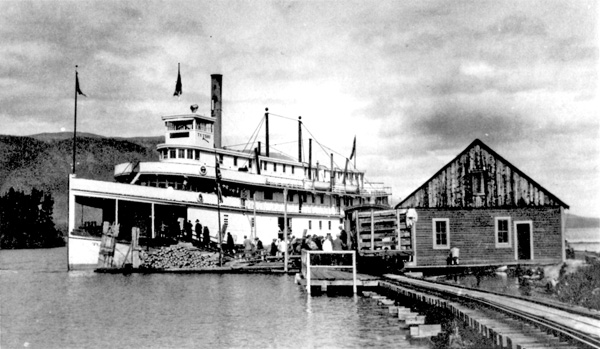
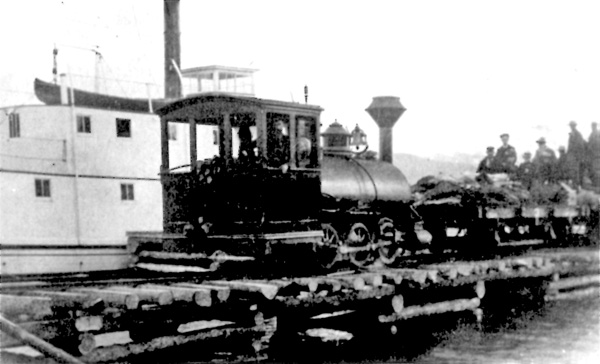
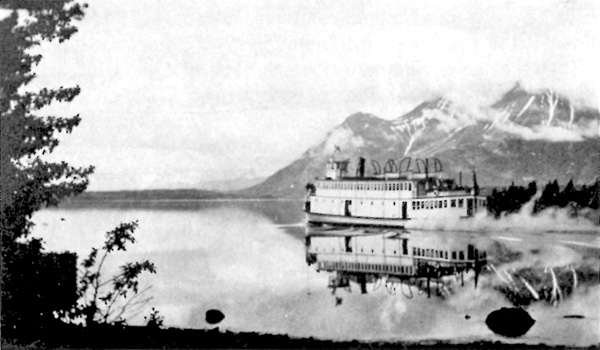
120-122 The highlight of a northern trip was an excursion
to Atlin Lake. Tourists detrained at Carcross and boarded
the SS Tutshi for either Ben-My-Cree, or Taku on the
west arm of Tagish Lake (Fig. 120.) At Taku, visitor's
climbed aboard a train for the two and one-half mile trip
(Fig. 121) to the MV Tarahne on Atlin Lake (Fig. 122).
(Public Archives of Canada, Yukon Archives, R. Kingston.)
|
V
The interwar period was a difficult time for the White Pass and
Yukon Route. Despite the demand for transportation created by the
successful establishment of the Mayo mines, tonnage statistics compiled
by the British Yukon Navigation Company show that shipments declined
from 28,000 tons before 1914 to 14,245 tons in 1928 and 18,121 tons in
1939.131
It is hardly surprising, in view of the interlocking nature of the
transportation system, that the railway experienced many of the same
difficulties. According to Walter Hamilton, mining activity,
supplemented to a large extent by tourism, just kept the wheels rolling
throughout this difficult period. Although the railroad historians
Thompson and Edgar could write that the "roadbed now [1933] compares
very favourably with that of any mountain railway in North America,"
their assessment belied the fact that the company was in serious
trouble. In 1928 Herbert Wheeler reported that the company was operating
on a very small margin and this margin progressively deteriorated during
the 1930s. It is said that Wheeler, who by this time had become
president, once mortgaged his house to pay his employees and that senior
corporate officials drew no salaries during the winter
months.132 It was not unusual for the company to request
payment in advance of delivery in order to maintain its attenuated
winter schedule and one official has recalled the desperate company
meetings called to decide which was more costly — to default on the
U.S. mail contract and pay the requisite penalty or to deliver the mail
on time. Dividends were all but forgotten, 1912 being the last year that
the shareholders were to realize a return on their investment until the
late 1950s.133
VI
Ironically, the economic vagaries of the 1914-39 era did not stifle
transportation development. If anything, retrenchment seems to have
forced a rationalization of the transportation system that might not
have occurred had prosperity been the distinguishing feature of the
period. The emergence of Whitehorse as the transportation hub of the
territory was part and parcel of this rationalization and anticipated
the transfer of the territorial capital from Dawson. Until 1923-24
the pattern of territorial transportation had confirmed Dawson's
quasi-metropolitan function, but that function could not survive the
economic decentralization that followed the rise of Mayo and so it was
that Dawson's one-time auxiliary, Whitehorse, came to be cast in the
former's role.
The most important single factor underlining transportation during this
period was the exploitation of silver-lead ore. The emergence of Mayo
not only wrought a change in transportation routes, thereby diminishing
Dawson's importance as a transportation centre, but also provided a
foundation for the existing transportation superstructure and a focus
for improvement and innovation in the types of transportation. Of these
innovations, the two most significant, the airplane and the tractor,
were added to the transportation system because of the efforts of Mayo
district miners and businessmen.
The evolution toward monopoly control of the mining industry in both the
Klondike and Mayo districts was in large measure a response to the
transportation problem. By reducing its commitment to the Yukon after
the First World War, especially in the area of finance, the government
indirectly fostered the growth of these monopolies as the only form of
economic organization with the capital resources necessary for
investment in power utilities and transportation, each of which was
vital to large-scale mining.
For all the improvements and innovations that marked the inter-war
period, two basic problems remained. While remoteness was alleviated in
a limited way by the airplane, it remained an intractable problem in
terms of heavy freight transport. The continuing dependence on river
transport, moreover, subject as it was to seasonal climatic changes,
delayed the conversion to all-season, overland transport — a
crucial requirement for economic development as the territory hung on
the verge of the mid-20th century.
|

